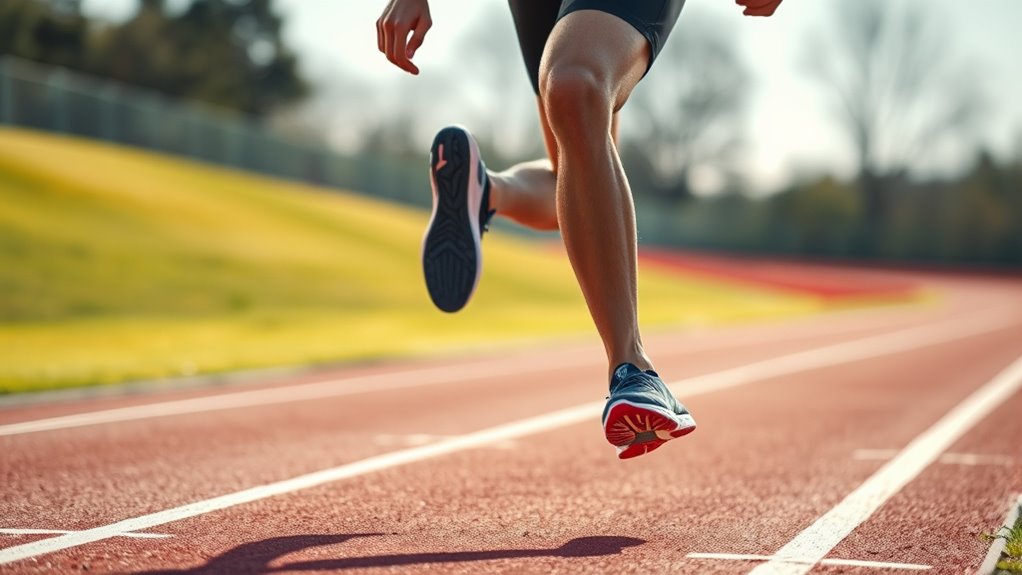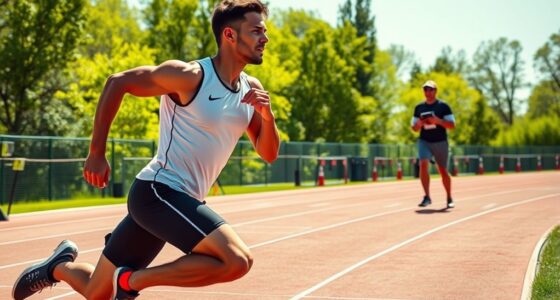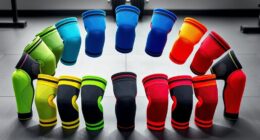Running economy involves how efficiently you use energy during running, influenced by biomechanics like stride length, foot strike, and posture, as well as physiological factors such as aerobic capacity and muscle efficiency. Optimizing your technique, strengthening muscles, and improving endurance can make your runs smoother and less effortful. Environmental factors like terrain also play a role. Understanding these elements helps you run smarter and longer—discover more ways to enhance your performance as you go along.
Key Takeaways
- Running economy depends on biomechanics like stride mechanics, foot strike, and posture to optimize energy use.
- Foot placement and strike pattern influence impact forces and efficiency, with softer landings reducing injury risk.
- Muscle strength, recruitment, and coordination improve propulsion and reduce effort during running.
- Aerobic capacity and VO2 max determine oxygen utilization, affecting endurance and running efficiency.
- Environmental factors such as terrain and surface hardness impact impact forces and overall running economy.
Understanding Running Economy and Its Importance

Understanding running economy is essential because it directly influences how efficiently you use energy during a run. Your running biomechanics, such as your posture, foot strike, and stride length, play a vital role in optimizing this efficiency. Small adjustments in these mechanics can reduce wasted energy and improve performance. Environmental factors also impact your running economy; terrain, wind resistance, and surface type can either hinder or help your efficiency. For example, running on a soft trail may require more energy than running on a firm track. Recognizing how these elements interact helps you make better choices to conserve energy, run longer, and perform at your best. Improving your understanding of these factors is key to becoming a more efficient, injury-resistant runner. Additionally, active listening and empathy during training can help you better understand your body’s responses and adapt your technique accordingly. Being aware of biomechanical and physiological factors allows you to tailor your training to maximize efficiency and reduce the risk of injury. Incorporating AI-driven analysis can further refine your technique by providing real-time feedback on your biomechanics and energy expenditure.
The Role of Stride Mechanics in Running Efficiency
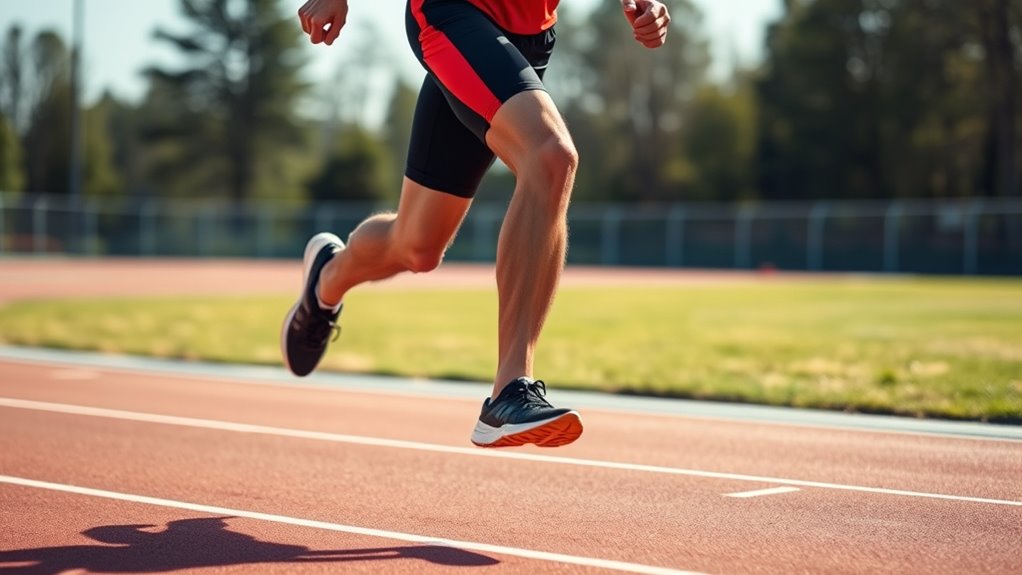
Your stride mechanics directly impact your running efficiency, starting with ideal foot placement that reduces unnecessary energy loss. Additionally, your arm swing influences your balance and rhythm, helping you maintain a smooth, efficient stride. Focusing on these elements can make a noticeable difference in how effectively you run. Incorporating proper technique into your training can further enhance your overall performance and reduce the risk of injury. Paying attention to biomechanics can optimize your running economy, leading to improved endurance and speed. Understanding biomechanical factors allows runners to tailor their training for maximum efficiency and injury prevention.
Optimal Foot Placement
Ideal foot placement plays a crucial role in enhancing running efficiency by influencing stride mechanics. Correct foot placement helps you maintain a balanced running posture, reducing unnecessary energy expenditure. When your foot lands directly beneath your hips, you promote a more efficient stride, minimizing braking forces and encouraging forward momentum. Proper foot placement also enhances your running posture by encouraging a slight forward lean and upright torso, which decreases strain on joints and muscles. By focusing on landing softly with a midfoot strike, you maximize shock absorption and energy transfer. Small adjustments to your foot placement can lead to significant improvements in running economy, allowing you to run longer and faster with less effort. Additionally, understanding the biomechanical factors involved can help optimize your running form for better performance and injury prevention. Recognizing the genetic variation that influences your gait and stride can further tailor your running technique.
Arm Swing Dynamics
Arm swing plays a vital role in optimizing stride mechanics and enhancing running efficiency. When you focus on rhythmic arm movement, you improve overall balance and conserve energy. Proper arm swing optimization helps you maintain a steady cadence and reduces unnecessary lateral motion, which can waste valuable energy. Keep your elbows bent at about 90 degrees and swing your arms forward and back in a controlled, relaxed manner. Engage your shoulders without overextending, ensuring your arm movement complements your leg stride. Consistent, rhythmic arm movement promotes better posture and momentum, allowing you to run more efficiently over long distances. By fine-tuning your arm swing, you can reduce fatigue and improve overall running economy, making each stride more effective. Additionally, muscle coordination plays a crucial role in maintaining fluid arm movement and overall running form. Proper biomechanical alignment further enhances efficiency by reducing strain and preventing injuries. Paying attention to your running posture also contributes significantly to sustaining energy and avoiding fatigue.
Muscle Function and Its Impact on Running Performance
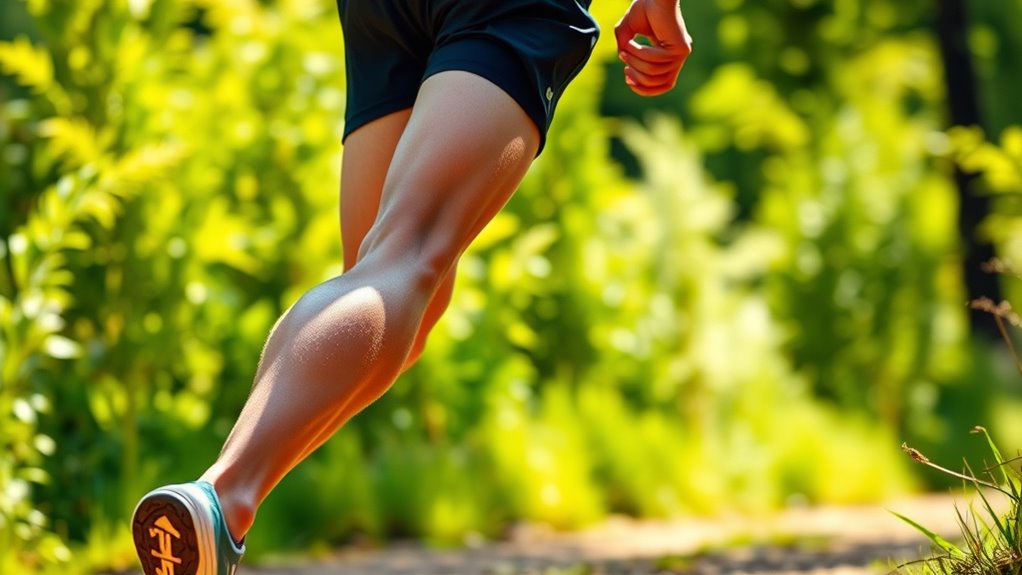
Muscle function plays a critical role in determining running performance because it directly influences how efficiently you generate force and sustain movement. Your ability to recruit the right muscles at the right time ensures smooth, effective strides. Proper muscle recruitment minimizes unnecessary effort, conserving energy during long runs. Additionally, effective fatigue management keeps your muscles functioning at their best, delaying the onset of tiredness that can reduce efficiency and compromise form. Strong, well-coordinated muscles contribute to better propulsion and stability, reducing the risk of injury. Enhancing muscle function through targeted strength training and proper technique helps improve running economy. By optimizing muscle recruitment patterns and managing fatigue, you can run more efficiently and sustain higher performance levels over longer distances. Incorporating training tips based on biomechanical principles can further elevate your running efficiency. Recognizing the importance of muscle coordination can lead to more effective training strategies that boost overall performance. Improving muscle activation through specific drills may also enhance your ability to sustain proper form under fatigue.
Metabolic Factors Influencing Energy Utilization

Have you ever wondered how your body determines the most efficient way to produce energy during a run? Your metabolic factors play a key role here. Fuel efficiency refers to how well your body uses stored energy sources, like fats and carbs, to sustain activity. A higher metabolic rate means your body burns calories faster, influencing your endurance and speed. When your metabolism adapts effectively, you utilize energy more efficiently, reducing fatigue. Factors such as muscle fiber type, enzyme activity, and mitochondrial function impact this process. By optimizing these metabolic components, you can improve your running economy. Understanding how your body manages energy helps you train smarter, enhancing performance while conserving effort. Additionally, metabolic efficiency can be improved through targeted training and nutrition strategies. Recognizing the influence of AI’s role in healthcare technology underscores the importance of integrating innovative solutions for better health outcomes. Ultimately, better metabolic efficiency translates into a smoother, more economical running experience. For example, muscle fiber composition can significantly influence how efficiently your muscles utilize different energy pathways during exercise.
The Effect of Ground Contact and Foot Strike Patterns
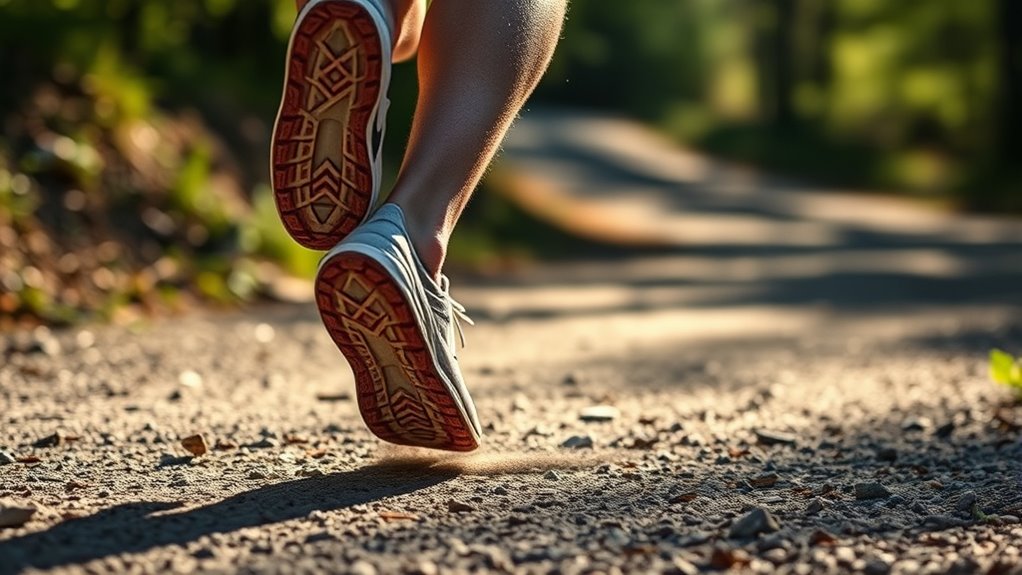
Your foot strike pattern influences how much impact force you absorb with each step. Different strike styles, like heel or forefoot running, can affect your efficiency and injury risk. Understanding these variations helps optimize your running economy. Incorporating data-driven strategies into your training can further enhance performance and reduce the likelihood of injury.
Impact Force Variations
Ground contact and foot strike patterns considerably influence impact forces experienced during running. Your choice of shoe cushioning can absorb some of these forces, but terrain variability also plays a significant role. Harder surfaces like concrete increase impact forces, while softer trails reduce them. A forefoot or midfoot strike tends to generate lower impact peaks compared to a heel strike, which often produces a sharper force spike. Properly cushioned shoes help mitigate these forces, decreasing stress on your joints and muscles. Variations in terrain demand different strike patterns and shoe responses, affecting impact force distribution. Understanding how ground contact influences impact forces enables you to select appropriate footwear and adapt your running on diverse surfaces, ultimately improving efficiency and reducing injury risk.
Strike Pattern Efficiency
Foot strike patterns considerably influence running efficiency by affecting how impact forces are absorbed and distributed across your body. Your foot strike type—heel, midfoot, or forefoot—impacts energy transfer and injury risk. To improve strike pattern efficiency, focus on cadence optimization, which can promote a more natural and effective foot strike. Proper footwear selection also plays a vital role, providing cushioning or support tailored to your gait. Additionally, understanding regional variations in divorce statistics can inform your expectations regarding recovery and adjustment after significant life changes. Consider these points:
- Midfoot strikes often reduce braking forces
- Forefoot striking can increase calf muscle engagement
- Heel striking may cause higher impact forces if not cushioned
- Adjusting cadence can promote a more efficient contact pattern
- Appropriate footwear enhances contact and reduces strain
- Proper running technique can help mitigate the risk of injury and improve overall running economy by optimizing impact absorption and energy transfer.
The Influence of Aerobic Capacity and VO2 Max

Aerobic capacity and VO2 max play essential roles in determining running economy because they directly influence how efficiently your body utilizes oxygen during exercise. A higher VO2 max means your body can consume and deliver oxygen more effectively, enhancing endurance and reducing fatigue. This improved efficiency is similar to how integrating smart home devices can streamline household tasks and save energy. The following table illustrates how improvements in aerobic capacity impact performance:
| Aspect | Effect |
|---|---|
| Increased VO2 max | Better oxygen delivery, improved endurance |
| Enhanced aerobic capacity | More efficient energy use during runs |
| Reduced effort at same pace | Less energy expenditure, improved economy |
Strategies to Improve Running Economy
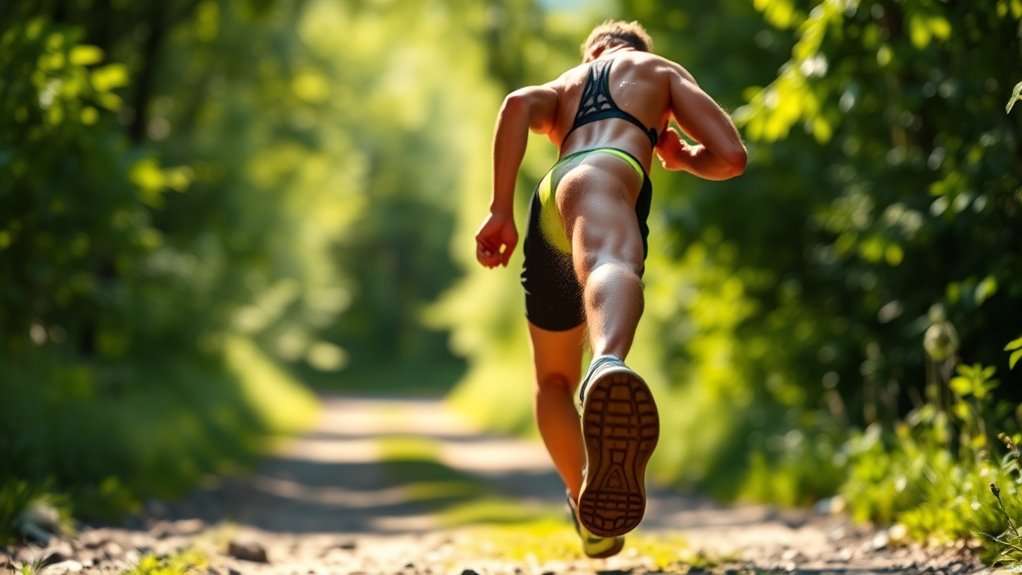
To improve your running economy, focus on specific training techniques that enhance efficiency and reduce energy expenditure. Building your aerobic capacity allows you to sustain effort longer with less fatigue, directly boosting running economy. Incorporate drills such as interval training and tempo runs to develop this capacity. Additionally, nutrition optimization plays a crucial role; fueling properly ensures your muscles function efficiently and recover faster. Concentrate on balanced diets rich in carbohydrates, proteins, and healthy fats to support sustained energy levels. Strength training can also improve biomechanics, reducing wasted movement. Finally, regular cadence work helps minimize vertical oscillation, conserving energy during runs. By combining aerobic capacity development with smart nutrition and biomechanics, you optimize your running economy and improve overall performance.
The Impact of Training, Nutrition, and Recovery
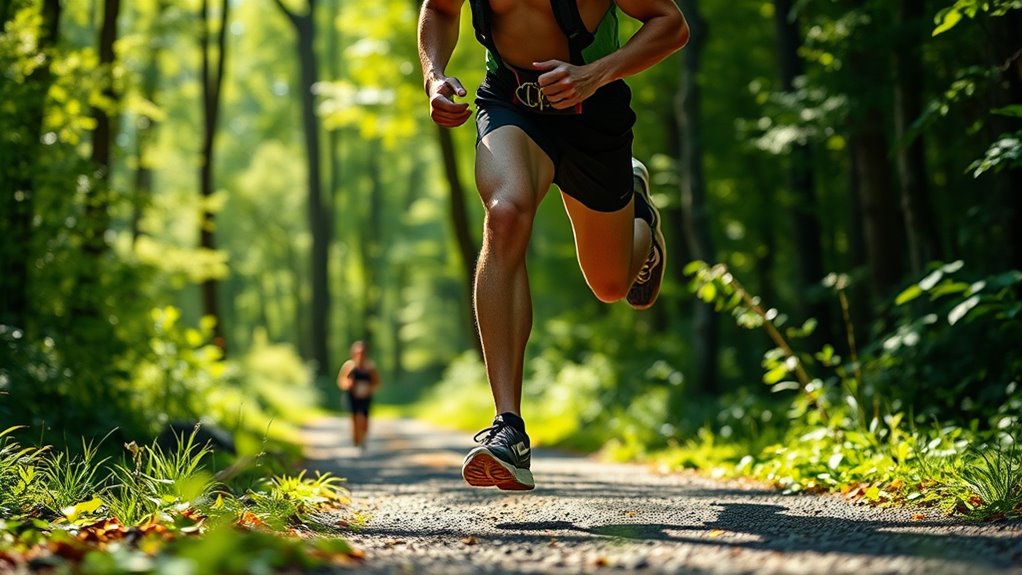
Building on your efforts to enhance running economy, paying attention to training, nutrition, and recovery can make a significant difference in your performance. Proper hydration strategies ensure your muscles stay fueled, preventing fatigue and injury. Nutrition supports energy levels and muscle repair, while consistent recovery helps adapt and strengthen your body. Mental resilience also plays a vital role, helping you push through tough workouts and setbacks.
| Focus Area | Key Actions |
|---|---|
| Training | Incorporate varied sessions and rest days |
| Nutrition | Prioritize balanced meals and hydration |
| Recovery | Use active recovery and adequate sleep |
| Hydration | Drink fluids regularly, especially during long runs |
| Mental Resilience | Practice mindfulness and positive visualization |
Frequently Asked Questions
How Do Environmental Conditions Affect Running Economy?
Environmental conditions considerably influence your running economy. When facing environmental adaptations like heat, humidity, or altitude, your body works harder to regulate temperature and oxygen intake, reducing efficiency. Terrain variability, such as uneven or hilly surfaces, demands more energy and alters your biomechanics, further impacting your economy. You may notice increased fatigue and slower times, as your body adapts to these conditions, affecting overall running performance.
What Role Does Footwear Technology Play in Efficiency?
Did you know that advanced footwear technology can improve running efficiency by up to 4%? Shoe cushioning reduces impact forces, helping you conserve energy, while a lower heel drop promotes a more natural stride. These design features optimize biomechanics, allowing you to run more effortlessly. By choosing shoes with the right cushioning and heel drop, you can enhance your running economy and perform better with less fatigue.
Can Mental Focus Influence Running Economy?
Mental focus definitely influences your running economy. When you practice mindfulness training and concentration techniques, you become more aware of your body and movement, helping you maintain proper form and conserve energy. Staying focused reduces distractions, minimizes unnecessary muscle tension, and keeps your mind engaged in your running rhythm. This mental clarity boosts efficiency, enabling you to run more economically and comfortably over long distances.
How Does Age Impact Biomechanical Efficiency?
As you age, your biomechanical efficiency declines due to decreased muscle elasticity and joint flexibility. These changes make your movements less agile, increase energy expenditure, and reduce stride length. You might find it harder to maintain proper posture and smooth gait patterns. To combat this, focus on regular stretching and strength training to preserve muscle elasticity and joint flexibility, helping you maintain better biomechanical efficiency over time.
Are There Genetic Factors That Determine Running Economy?
You might wonder if genetics influence your running economy. Genetic predisposition and inherited traits can play a role by affecting muscle fiber composition, limb length, and metabolic efficiency. These factors can give some runners an advantage in energy use and biomechanics. While training is essential, your genetic makeup can set a baseline, making certain aspects of running economy easier or harder for you.
Conclusion
Now that you understand the key factors behind running economy, the real question is—what’s stopping you from unlocking your true potential? Every stride and breath holds the power to transform your performance, but only if you know how to harness these biomechanics and physiological secrets. Are you ready to push beyond limits and discover what you’re truly capable of? The answer lies ahead—your next move could change everything.
